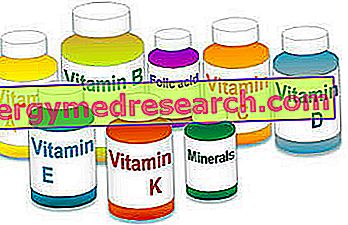Generality
The dark circles of the eyes are unsightly dark marks or halos that appear below the lower eyelid .

Although they are not a medical problem, dark circles can represent an aesthetic defect for a large number of people, because, with their edges, they emphasize the periocular region. The effect produced by their presence is, therefore, that of a tired face, with a dull and non-homogeneous complexion .
Black circles may appear for a variety of reasons. Among the most common reasons are particularly intense stress, dehydration, poor rest, alterations of skin pigmentation, poor diet, capillary fragility and atopic or allergic contact dermatitis . Sometimes, even dark circles may be among the symptoms of anemia or thyroid disorder.
The treatments available for these undesirable dark halos are different and involve more or less invasive cosmetic remedies and aesthetic medicine procedures.
What are
We talk about dark circles when the area under or around the eyes takes on a darker color than the rest of the complexion . Depending on the triggering factors, these signs can be purplish, bluish or tending to brown-gray .
Characteristics of the periocular area
With respect to the rest of the face, the skin surrounding the eyes (periocular area):
- It is thinner ;
- Characterized by a smaller number of sebaceous and sweat glands;
- Prepared to develop black circles, spots, fine lines and bags.
Furthermore, around the eyes, the subcutaneous fat is present in smaller quantities, just as the dermal matrix contains less collagen and elastic fibers . For these reasons, the periocular (or periorbital) area is so fragile and sensitive. Furthermore, the area is subjected to the stresses of facial expressions and is affected by the action of the sun, wind and temperature changes.
Added to this is the fact that the venous and lymphatic microcirculation is slowed down, a feature that makes the skin susceptible to stagnation of interstitial fluids and blood, therefore subject to swelling and the onset of dark circles and bags.
Causes
The onset of dark circles is a complex phenomenon, which recognizes multiple etiological factors .
- Among the main reasons for the onset of dark circles is a process of dermal darkening from deposits of melanin ( hyperpigmentation ) or hemodynamic congestion .
- In practice, the slowing down of venous and lymphatic microcirculation, which causes a stagnation of blood, with deposit of liquids ( periorbital edema ) and pigments, and gives the periocular area the typical bluish-brown color .
- If the halo under the eye is dark brown, it is probable that there is an alteration of the normal pigmentation caused by the production of a greater quantity of melanin in the basal layer of the epidermis. This substance, migrating to the surface, gives the dark circles a darker shade (in the same way as happens, for example, for sunspots). Hyperpigmentation can occur even if you are exposed to the sun without adequate protection, regardless of the color of the complexion. Among the strategies useful for the prevention of dark circles under the eye are, in fact, the use of sun glasses and cosmetics for the eye area equipped with an anti-UV filter.
- Black circles are made more evident by the presence of a particularly thin (or almost translucent) skin in these areas. In some people, the superficial position of the vascular system contributes to accentuating these signs.
- Dark circles can be caused by the triggering of a local inflammatory process . In particular, hyperpigmentation is post-inflammatory and may be secondary to:
- Atopic dermatitis;
- Allergic contact dermatitis;
- Solar exposure ;
- Minor local traumas (like when, for example, you rub your eyes and irritate the area by touching it with your hands).
Note : water retention in the eye area can also cause the onset of bags.
Dark circles: why are they dark?
Dark circles are mainly due to the accumulation of cutaneous chromophores (substances that give color to the skin) and vascular stasis . These conditions are difficult to distinguish, as they can be contemporary and, in some way, connected.
The main cutaneous chromophores involved in the onset of dark circles are:
- Hemoglobin and derivatives : in post-inflammatory hyperpigmentation, the area under the lower eyelid can vary from blue-violet to yellow, due to the presence of hemoglobin (red protein that forms in the bone marrow and carries oxygen to the cells ) and products deriving from its degradation (hemosiderin, bilirubin, etc.). This type of dark circles is usually temporary and tends to resolve spontaneously within a short time. Otherwise, they can be a symptom of a different underlying condition, such as poor kidney function, poor digestion or liver disorders.
- Melanin : the pigmentation of dark circles can be attributed to hypermelanosis around the eye. The accumulation of melanin makes the area below the lower eyelids of brown-black color. In addition to the color, this type of dark circles can be distinguished by the more blurred edges.
The dark appearance of black circles may also be due to:
- Loss of fatty tissue in the eyelid or around the eye (for example, due to the aging process or smoking habit);
- Swollen eyelids (may depend on personal predisposition, dermatitis, allergy, thyroid disease and other systemic conditions);
- Thin and translucent skin (this aspect of the epidermis around the eyes is influenced by genetic factors and age; the combination with a fair complexion often emphasizes black circles);
- Shadows due to the anatomical shape of the orbit (it is more evident in the presence of tiredness or lack of sleep, periorbital edema and dehydration).
Black eye shadows can also be favored by superficially positioned blood vessels and blood stasis.
In some people, the appearance of dark circles under the eyes depends on a genetic predisposition ; in this case, the somatic tract tends to appear during childhood and adolescence.
Dark circles: possible associated disorders
The dark circles can be found in the presence of particular conditions, pathological or not.
- Allergies . Seasonal allergic reactions can often be accompanied by black circles; in addition to burning eyes, a feeling of a stuffy nose and a pinching throat, this sign may depend on contact with an allergen. At the systemic level, this causes the activation of histamines which are activated, causing a dilation of the blood vessels. This last phenomenon will not produce any effect in areas of the body where the skin is thicker; under the eyes, where the epidermis is extremely thin, however, the allergic reaction will make the eyelids appear more swollen and dark.
- Sleep disorders . Insomnia, sleep deprivation or particularly restless sleep, with frequent awakenings during the night, can contribute to the formation of dark circles. In fact, when not sleeping, the blood vessels in the area under the eyes tend to dilate, thus giving rise to the dark circles under the lower eyelid, which could also appear more swollen. Even the opposite situation, that is an excess of rest, can contribute to the appearance of black circles.
- Dehydration . The lack of water affects the whole organism; at skin level, this results in the loss of elasticity of the skin, which can be particularly evident especially in the area under the eyes. In particular, the thin, dehydrated epidermis may appear almost transparent, emphasizing black circles.
- Anemia . Dark circles may appear as a symptom of anemia, a condition characterized by a lack of red blood cells or hemoglobin. In this case, dark halos under the eyes can be accompanied by many other symptoms, including pallor, tiredness and dizziness.
Additional causes of the dark circles under the eyes are:
- Cry;
- Continuous use of eyeglasses (it is responsible for a mechanical stress in the area under the eyes);
- Lifestyle (smoking, drinking alcohol or too much coffee, excess dietary salt, etc.);
- Fluid retention, as can happen with pregnancy or weight gain;
- Mononucleosis;
- Periorbital cellulitis (bacterial infection of the eyelid (s)).
Symptoms
The dark circles can be defined as bilateral hyper-pigmented signs, round and homogeneous, which emphasize the periocular (or periorbital) region with their more pronounced and clearer or less blurred edges.
The onset of these signs can occur in different ways: in some cases, they are always present, other times they are visible especially in the morning, after lying down.
The dark circles are distinguished by the color (more or less dark, tending to brown or blue).
Types of black circles
Based on the causes and appearance with which they arise, it is possible to distinguish:
- Constitutional black circles : they appear as a hyperpigmented sign of dark, greyish or brownish color, which affects the area under the lower eyelid;
- Post-inflammatory black circles : they appear with halos that can vary from blue-violet to yellow;
- Black vascular dark circles : in this case the coloring is bluish; this shade is due to the extreme thinness of the skin that reveals the underlying blood vessels;
- Dark shadows with "shadow effect" : they consist of a dark halo that appears evident under the tarsal muscle which, when illuminated, disappears.
Diagnosis
In consideration of the fact that multiple factors contribute to the determination of dark circles, it is essential to identify the cause to choose the most appropriate treatment.
For this purpose, it is advisable to contact a dermatologist, who can give useful indications to correct the pigmentation of the lower eyelids.
The diagnosis of dark circles under the eyes may also involve the collection of personal and family history data and the physical examination of the area. To check for an allergy or anemia, your doctor may indicate a complete blood test.
Treatment
The treatment of dark circles under the eyes depends fundamentally on the causes; The strategies available to remedy the problem range from cosmetics for the eye area to medical and surgical aesthetic procedures.
Cosmetics for the eye area
As for the hyperpigmentation of the periocular area, we must first prevent the onset of the problem by always using cosmetic products for the eye area. Besides being specific, the most suitable formulations for maintaining this area are delicate and hypoallergenic. In fact, some disorders, such as eye irritations, are often a consequence of the use of cosmetics not suitable for the eye area. In addition to correcting expression wrinkles and toning the periocular area effectively, creams, serums or eye contour gels may contain microcirculation activators and sunscreens, useful for preventing melanin deposits and photo damage. -aging.
Another trick to minimize dark circles is to apply cosmetics based on illuminating agents or pigmented correctors for effective camouflage. It should be noted that these latter solutions can only hide the black spots and halos under the eyes, limiting themselves to cover the problem without solving it.
Medical and surgical aesthetic procedures
In very rare cases, if a solution is desired for dark circles under the eyes, the dermatologist can indicate the use of surgery (eg blepharoplasty, lifting etc.) to remove excess fat, muscles and skin.
In general, to reduce skin pigmentation, we prefer to opt for less invasive dermatological and aesthetic medicine interventions, such as:
- Lipofilling to counteract the shadow effect due to the loss of tissue with age (dermal implants; for example: injections of hyaluronic acid or fat grafts);
- Exfoliating peeling to reduce fine lines and superficial pigmentation;
- Laser treatments or intense pulsed light ( IPL ).
These treatments act on the dark parts, around the eyes, regenerating the dermis from the inside and making the area more toned. In many cases, however, it is necessary to plan different treatments to eliminate dark circles to optimize the results.
Natural remedies
To make the dark halos around the eyes less obvious, there are also natural remedies, such as applying cucumber slices for a few minutes (better if they are previously cooled in the fridge) or well-wrung chamomile sachets. Potato slices or tomato juice can also be effective in reducing the appearance of prominent blood vessels. Clearly, these tricks soften dark circles temporarily, but they are not at all invasive and can be used if necessary.
Prevention
To prevent the appearance of black circles around the eyes, you can follow some tricks:
- Drink a lot during the day: if the body is well hydrated, the skin also benefits, including the area around the eyes, appearing brighter and with less discoloration.
- Avoid smoking and limiting alcohol intake : these vices can also affect dark circles.
- Resting well and getting rid of stress : sleeping the appropriate number of hours (the ideal would be 8 hours a night), taking a less hectic lifestyle and practicing activities that alleviate tension can help to minimize dark circles and signs of tiredness around the eyes. If bags and dark circles become a recurring problem, the hours of night rest should be adjusted differently.
- Protect the eye area with sunglasses .
- Adopt a healthy diet: the diet can help to counteract the dark rings around the eyes. In particular, foods rich in antioxidants and other useful substances for the micro-circle, such as green or black tea, blueberries and grapes should be preferred. Even foods rich in vitamin C and K, such as citrus fruits, kiwi, tomatoes, strawberries and lettuce, are able to strengthen the capillaries and help reduce the phenomenon of dark circles.



